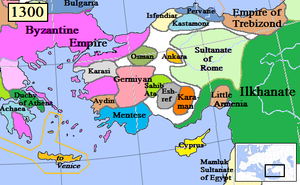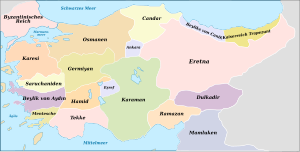Beylik
The term Beylik ( Turkish : sing.Beylik , pl.Beylikler ; Ottoman : sing.بكلك Beğlik , pl.بكلكلر Beğlikler ) refers to the Turkish principalities that had formed in Anatolia on the border with the Byzantine Empire from the 11th century. The beyliks wereadministered patrimonial , which meant that all land was owned by the bey and that control over the paternal line was passed on. Hence the Beyliks bore the name of the founder of the dynasty.
The phase of the Beyliks extends from the Battle of Manzikert in 1071 to the beginning of the 16th century, when all of Asia Minor became part of the Ottoman Empire . There are two phases. In the 1st phase from 1071 to 1243 the Beyliks from the Rum Seljuq Empire v. a. set up as buffer states to the neighboring Byzantines and Cilicians.
After the Rum-Seljuk ruling house had recognized the upper hand of the Mongolian Ilkhan in 1235 and was defeated in the Battle of the Köse Dağ against the Ilkhan in 1243 , Turkish tribes increasingly migrated to Central and Western Anatolia and founded their principalities here. This is where the Turkish resistance to the Mongol siege of Anatolia began in the 1260s. The Ottoman Empire came into being under these conditions. From 1261, Anatolia was divided into two areas of power (see figure). In Eastern Anatolia, the Mongolian Ilkhans and the Turkish Rum Seljuks, who were dependent on them, ruled; in Western Anatolia, the autonomous Turkish principalities ruled. All principalities founded in the 13th century had to be appointed as Bey / Emir by the Seljuk Sultan. To accept the title of Sultan would mean a rebellion against the Seljuk Sultanate. The principalities can be divided into those that arose on the western border of the Seljuk Empire (among others the principalities of the Eşrefoğulları , the Hamidoğulları , the Sâhipataoğulları , the Germiyano ğulları, the Çobanoğulları , the Karamanoğulları , the territory of byzroğulları ) originated (e.g. Menteşe , Aydınoğulları , Saruchaniden , Karesi , Osman ). Another group emerged in the border area to the Mamluk Empire (e.g. Ramazanoğulları, Dulkadıroğulları).
Initially, the area between the Ankara-Aksaray line to Erzurum was under the administration of the Ilhani Governor General until 1336 . After the dynasty was weakened by internal power struggles, the Beyliks in Anatolia received their complete independence. In addition there were newly founded Beyliks on the former possessions of the Ilhan Governors General.
The Ottomans were one of those principalities founded in the Eskişehir and Bursa area . The principality under the rule of the Ottoman dynasty was able to conquer the other principalities through strategic marriages and successful campaigns. This is how political unity was established in the west of Asia Minor.
During the rule of the Beyliks, the Turkish language and culture in Anatolia developed rapidly. During this time, the Turkish language was used in science and literature. It established itself as the official language in the principalities. In the Beyliks, new universities emerged and medicine made progress.
Gülşehri , Nasīmī († 1404), Ahmedi (1325–1412) and Ahmed-i Dāʻī are well-known Turkish-speaking poets of this time.
Sufi orders had considerable influence in some cases. Important Sufi mystics who worked in Anatolia at this time were e. B. Yunus Emre and Hajji Bektash .
List of principalities
After the battle of Manzikert
In the battle of Manzikert (north of Lake Van ) the Byzantine emperor Romanos IV. Diogenes was defeated on August 26, 1071 by the Turkish Seljuks under Alp Arslan . This battle played a decisive role in the temporary collapse of the Byzantine resistance and initiated the Turkish settlement in Anatolia with the immigration of numerous Oghusen / Turkmen .
| Surname | Capital | Duration |
|---|---|---|
| İzmir Çaka Beyliği | İzmir | 1081-1098 |
| Dilmaçoğulları Beyliği | Bitlis | 1085-1192 |
| Danischmenden | 1092-1178 | |
| Saltukids | Erzurum | 1092-1202 |
| Ahlachahs | Ahlat | 1100-1207 |
| Ortoqids | 1102-1408 | |
| İnaloğulları Beyliği | Diyarbakir | 1098-1183 |
| Mengücek | Erzincan | 1072-1277 |
| Çubukoğulları Beyliği | Çemişgezek | 1085-1092? |
After the battle of Köse Dağ
The Battle of Köse Dağ took place in Anatolia between June 26th and July 3rd, 1243 between the Mongols and the Seljuk Sultanate of Rum and ended with a clear victory for the Mongols under their leader Baiju . The immediate consequence was the decline of the Sultanate of Rum and the rule of the Mongols over most of Anatolia .
| Surname | Capital | Duration |
|---|---|---|
| Çobanoğulları Beyliği | Kastamonu | 1227-1309 |
| Karamanoğulları Beyliği | Karaman | 1256-1483 |
| İnançoğulları Beyliği ( Ladik Beyliği ) | Denizli | 1261-1368 |
| Sâhipataoğulları Beyliği | Afyonkarahisar | 1275-1342 |
| Pervâneoğulları Beyliği | Sinop | 1277-1322 |
| Mentesche | Milas | 1280-1424 |
| Osmanoğulları Beyliği | Bilecik - Yarhisar - Yenişehir - Inegöl | from 1288 (smooth transition into the Ottoman Empire ) |
| Candaro ğulları Beyliği | Kastamonu | 1299-1462 |
| Karesio ğulları Beyliği | Balikesir | 1297-1360 |
| Germiyano ğulları Beyliği | Kutahya | 1300-1423 |
| Hamidoğulları Beyliği | Egirdir | 1301-1423 |
| Saruhanoğulları Beyliği | Manisa | 1302-1410 |
| Taceddinoğulları Beyliği | Niksar | 1303-1415 |
| Aydınoğulları Beyliği | Birgi | 1308-1426 |
| Tekeoğulları Beyliği | Antalya | 1321-1390 |
| Eretna | Sivas , Kayseri | 1335-1381 |
| Dulkadıroğulları Beyliği | Elbistan | 1339-1521 |
| Ramazanoğulları Beyliği | Adana | 1325-1608 |
| Kadi Burhan al-Din | Kayseri | 1381-1398 |
| Eşrefoğulları Beyliği | Beyşehir | Mid-13th century - 1326 |
See also
literature
- Claude Cahen: Pre-Ottoman Turkey. A general survey of the material and spiritual culture and history c. 1071-1330. Translated from the French by J. Jones-Williams. Taplinger Publ. Co., New York NY 1968.
supporting documents
- ↑ Halil İnalcık : Devlet-i ʿAliyye. Osmanlı İmparatorluğu üzerine araştırmalar. Volume 1: Klasik dönem (1302-1606). 30. baskı. Türkiye İş Bankası Kültür Yayınları, İstanbul 2009, ISBN 978-9944-88-645-1 , p. 5.
- ↑ a b Halil İnalcık: Devlet-i ʿAliyye. Osmanlı İmparatorluğu üzerine araştırmalar. Volume 1: Klasik dönem (1302-1606). 30. baskı. Türkiye İş Bankası Kültür Yayınları, İstanbul 2009, ISBN 978-9944-88-645-1 , p. 7.
- ↑ Halil İnalcık: Devlet-i ʿAliyye. Osmanlı İmparatorluğu üzerine araştırmalar. Volume 1: Klasik dönem (1302-1606). 30. baskı. Türkiye İş Bankası Kültür Yayınları, İstanbul 2009, ISBN 978-9944-88-645-1 , p. 11
- ↑ the capital is unknown, but original documents from 1324 prove that Osman must already have had a palace. Halil İnalcık: Devlet-i ʿAliyye. Osmanlı İmparatorluğu üzerine araştırmalar. Volume 1: Klasik dönem (1302-1606). 30. baskı. Türkiye İş Bankası Kültür Yayınları, İstanbul 2009, ISBN 978-9944-88-645-1 , pp. 13, 339

